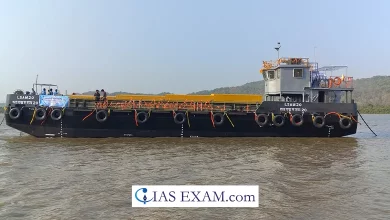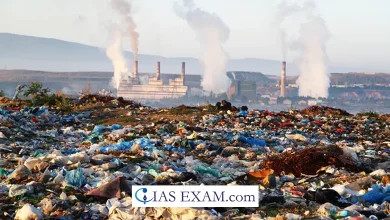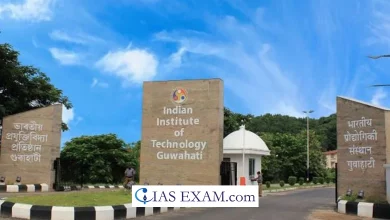Daily Current Affairs for UPSC
COP 27 and UNFCCC
Topic- Important Institutions [GS Paper-2]
Context- Union Environment Minister has recently disclosed that ‘Loss and damage’ due to climate change will be a major topic for discussion at the 27th Conference of Parties to the UNFCCC in Egypt in November.
Key Highlights
- According to the World Resources Institute, the term “loss and damage” is used in UN climate negotiations to refer to the consequences of climate change that go beyond what people can adapt to or when options are there but a community doesn’t have the resources to access or utilise them.
- The UNFCCC parties will be holding discussions on Loss and damage as a major topic at COP27 at Sharm El Sheikh in Egypt in November this year 2022.
- The social and financial effects of climate change that cannot be avoided are referred to as ‘loss and damage’.
- Loss and damage are generally resulted from extreme weather conditions like cyclones, droughts, heatwaves, and slow-onset changes such as sea level rise, desertification, glacial retreat, land degradation, ocean acidification, and salinization etc.
- In some cases, damages may permanently change some places; for instance, rising seas encroaching on low-lying islands, or drought shrinking freshwater resources and turning once-productive farmland into barren land.
- India is one of the few countries which have achieved the goal nine years before schedule; set under the Paris Agreement with regard to increasing the use of non-fossil fuels.
- India had committed to achieve 40% of its installed electricity capacity from non-fossil energy sources by 2030 which has already been achieved by the country in November 2021 itself.
- India has updated its nationally determined contributions in keeping with the promises made by it at COP26 in Glasgow.
- According to the updated Nationally determined contributions (NDCs), India now stands committed in reducing the emissions intensity of its GDP by 45% by 2030, from the 2005 level, and achieving about 50% cumulative electric power installed capacity from non-fossil fuel-based energy resources by 2030.
- For the maintenance of a healthy and sustainable lifestyle, ‘LIFE’ – ‘Lifestyle for Environment’ as a key to combating climate change” has been added to India’s NDC.
- Developed countries, which have 17% of the world’s population, account for 60% of the global carbon emissions.
- Whereas, India is home to 17% of the world’s population and is responsible for only 4% of the global carbon emissions. This is due to the adoption of a sustainable lifestyle.
United Nations Framework Convention on Climate Change (UNFCCC)
- UNFCCC was signed in 1992 at the United Nations Conference on Environment and Development also known as the Earth Summit, the Rio Summit or the Rio Conference.
- But it came into force on 21st March 1994 which was ratified by 197 countries and is called to have a near-universal membership.
- The countries that are part of the convention are called the UNFCCC conference of parties (COP).
- The latest, COP27, is scheduled to be held in Sharm El-Sheikh, Egypt in November 2022.
- UNFCCC is the primary multilateral treaty which manages actions to combat climate change through adaptation and mitigation efforts directed at control of emission of Green House Gases (GHGs) that cause global warming.
- Even though climate change is a global concern some of the developed countries are majorly responsible for greenhouse gas emissions into the atmosphere.
- Many island nations are facing the major impacts of Climate Change in the form of sea-level rise, cyclones, erratic weather conditions, etc.
- UNFCCC is a major step in the direction to combat the downward spiral of climate change.
Objective-
- The objective of the convention is mentioned in Article 2, which says “to achieve stabilization of greenhouse gas concentrations in the atmosphere at a level that would prevent dangerous anthropogenic interference with the climate system”.
- This objective should be achieved within a time frame sufficient to allow ecosystems to adapt naturally to climate change, to ensure that food production is not threatened and to enable economic development to proceed in a sustainable manner.
Structure-
- The Conference of the Parties (COP)
-
-
- Article 7.2 defines the COP as the “supreme body” of the UNFCCC, as it is its highest decision-making body.
- All the measures related to climate change are decided in the annual sessions of the COP.
-
- COP President and Bureau
-
-
- The office of the COP President rotates among the five United Nations regional groups.
- The environment minister of his or her home country is appointed as the president of COP.
- She or he is elected by acclamation immediately after the opening of a COP session.
- The role of the president is to facilitate the work of the COP and promote agreements among Parties.
- The work of the COP and each subsidiary body is guided by an elected Bureau in order to ensure continuity; it serves not only during sessions, but between sessions as well.
-
- Subsidiary Bodies (SBs)
-
-
- The Convention has set up two permanent subsidiary bodies (SBs), namely the Subsidiary Body for Scientific and Technological Advice (SBSTA), under Article 9, and the Subsidiary Body for Implementation (SBI), under Article 10.
- These bodies act as advisory bodies to the COP.
- The SBSTA’s duty is to provide the COP “with timely advice on scientific and technological matters relating to the Convention”.
- Whereas it is the duty of SBI to assist the COP “in the assessment and review of the effective implementation of the Convention”
-
- The Secretariat
-
-
- It is also known as the Climate Change Secretariat which serves the COP, the SBs, the Bureau and other bodies established by the COP.
-
- Other Bodies
-
- Other bodies have been set up by the COP to undertake specific tasks and after they complete their work the bodies report back to the COP.
- Two ad hoc groups were established to conduct negotiations on specific issues.
- Whereas COP 11 established the “Dialogue” to exchange experiences and analyse strategic approaches for long-term cooperative action to address climate change.





.png)



